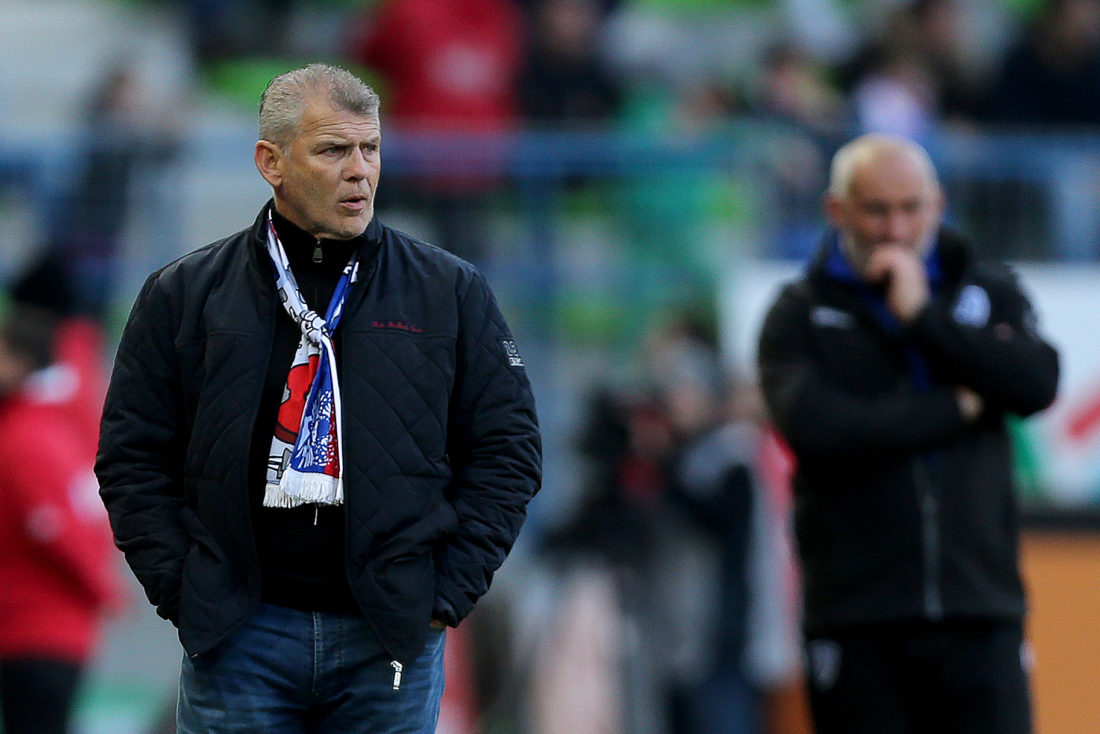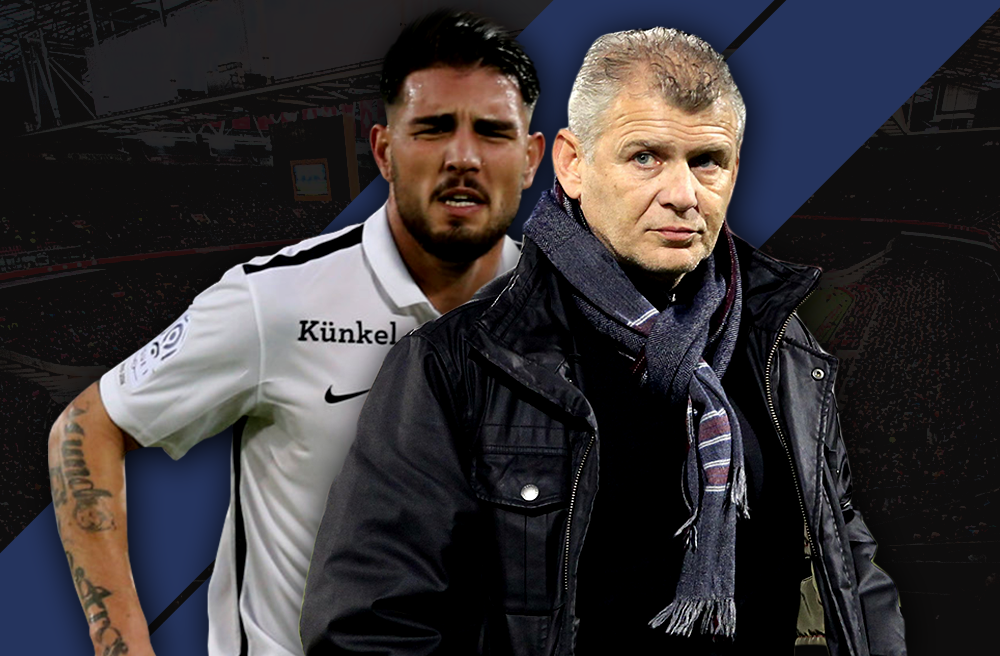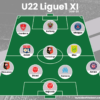
Being a football hipster is serious business with knowledge about the young starlet making waves for a non-mainstream mid table side often a prerequisite rather than a feather in the cap. To further enhance your, perhaps, burgeoning reputation as a true hipster, Outside of the Boot is on hand to provide an in-depth guide to some of the less celebrated teams around Europe. In this edition of the series, Eric Devin tells us about Caen.

THE PREVIOUS CAMPAIGN
Knocking at the door of Europe before a winless April stunted their hopes last campaign, Caen have progressed impressively under the control of Patrice Garande. Promotion in 2013-14 was followed by a 13th place finish two years ago, including a brilliant spell of six wins in seven matches that rocketed the club from the bottom of the table to 12th place. Some uneven results followed, but survival was achieved comfortably enough, even if the defense was somewhat uneven.
Despite the sales of Thomas Lemar and N’Golo Kante, the team did do well to strengthen in defense, bringing in Syam Ben Youssef and Ismael Diomande, which, combined with the continued development of Damien da Silva, powered the club to last season’s seventh-placed finish. Andy Delort also arrived from Wigan, ending his unhappy spell in England and easily replacing the production of Mathieu Duhamel with a dozen goals. There was admittedly some element of smoke and mirrors to last season, as the club had the worst goal difference of any non-relegated side in the league, but the team was still nonetheless one of Ligue 1’s most eye-catching.
MANAGER PROFILE
Patrice Garande enters his fifth season in charge of Caen under no great pressure, and will hope to push his team into the European places, continuing their steady rise. Having come through the youth ranks of Saint-Etienne, Garande carved out a successful, if somewhat itinerant career in Ligue 1, playing for almost a dozen clubs. His best years came at Auxerre, where he led the league in scoring in the 1983-84 season before being a part of France’s 1984 Olympic Champions. After retiring in 1995, he joined the staff of Pierre Mankowski at Caen, spending three years there before leaving to become technical advisor at Cherbourg.

Patrice Garande has been on Caen’s coaching staff since 2005. CHARLY TRIBALLEAU / AFP / Getty Images
Within a year, he was named manager, earning the team promotion from the CFA (France’s fourth division) in 2001-02, with the best defense and second-best attack. Two years of mid-table finishes in the third-tier National were impressive enough for the promoted side, but Garande left in 2004 at the end of his contract. After leaving the coastal city, he moved inland some 60 miles, re-joining Caen, working first under Patrick Parizon and then Franck Dumas. After Caen suffered a third relegation under Dumas in 2012, Garande was given his chance, and promptly brought the club back up in his second season. Now firmly established as one of the division’s best managers, Grande has become a favorite for his energetic approach and bold play, succeeding despite the club’s limited means.
TACTICAL APPROACH
Garande’s first season with Caen was one of narrow disappointment, as the club just missed promotion, a crucial loss to Nantes late in the season dashing their hopes of going up, Les Canaris finishing in third place ahead of their Norman competitors. Still, the club had the division’s second best defense, and youngster Raphael Guerreiro was one of Ligue 2’s brightest stars at just 18. The following season saw promotion, and then consolidation in the top flight. Now a few seasons on, Garande and sporting director Alain Caveglia have cannily built an exciting and forward-thinking squad, well-suited to the manager’s approach.
The players left to Garande by Dumas have largely departed, save defensive midfielder Nicholas Seube, and the squad has evolved in a similar fashion, cohering into an aggressive 4-1-4-1. Whereas Garande had, in the lower levels of French football, built his reputation on defending to the hilt, he has now come to be regarded as one of, if not the most impressive practitioners of a high-pressing, counter-attacking style in France. This has, to be fair, come at the expense of the team’s defensive record, but their placement in the table should quell any doubts about the tactic’s sustainability.
The defense, remodeled by Garande around the increasingly impressive Damien da Silva, is only nominally protecting veteran goalkeeper Remy Vercoutre. Da Silva, who is partnered by one of Ben Youssef or Alaeddine Yahia, is an interesting case. While his partners are traditional center backs, da Silva, a Bordeaux youth product, is somewhat undersized at just a shade under six feet, and his style of play belies his developing years, where he was generally used as defensive midfielder. His willingness to come forward from central defense to break up opposing attacks often leaves holes for the opposition, but his ability in the tackle, dribbling and in playing long balls make his particular combination of multivalency and physical robustness difficult to contend with for opposing attackers.
The fullbacks last season, Dennis Appiah on the right and Emmanuel Imorou on the left, were similarly adventurous. While Imorou was sometimes spelled by Vincent Bessat, (more on him in a moment) both players were aggressive in getting the ball off opponents and starting counterattacks, adept dribblers and willing crossers of the ball. Appiah has moved to Belgian side Anderlecht, but Chaker Alhadhur, brought in from Nantes last summer, will be a competent replacement. With such an aggressive defence, much onus is necessarily placed on the defensive midfielder, in this case Seube.
An elegant if not exactly fleet of foot presence in front of the defence, Seube rarely puts a foot wrong, covering for da Silva and relying on the younger player’s pace to cover his tracks. Conversely, while da Silva and the other center backs are somewhat middling in terms of playing long balls, Seube is fine indeed. Thus, while Caen function with one holding midfielder, the role can be played by different players depending on the phase of play, with one of Ismael Diomande or Jordan Adeoti providing a more mobile option in place of Seube when necessary.
Further forward, central midfield is the province of Julien Feret and Jonathan Delaplace, the latter having arrived from Lille to replace N’Golo Kante. While, given the reputation Kante has come to enjoy since joining Leicester, Delaplace may seem a precipitous drop in quality, he and Feret enjoy a similar type of symbiosis. The former Rennes player is one of Ligue 1’s best at delivering crosses when drifting wide or playing balls over the top, providing six assists and also making Caen dangerous from set pieces. Delaplace, meanwhile, functions as a safety valve for the 34 year-old Feret, his energy and short passing allowing Caen to win the ball quickly.
The two wide players, Vincent Bessat and Ronny Rodelin are quite different in their approaches, but each provide a necessary component to the team’s ethos. Bessat, long a stalwart under Michel der Zakarian at Nantes, can play left back, but was often used further forward by Garande. A hard worker and a strong crosser of the ball, Bessat provides an ideal counterpart for the man on the other side of the pitch, Rodelin. Loaned from Lille last season and now signed permanently, the big forward is more suited to dropping behind the striker than playing in wide areas. A superb header of the ball, his aerial abilities make him the ideal target for the long balls of Feret and Seube, allowing striker Andy Delort a great freedom of space between the lines. His height also makes him a fine outlet at set pieces, either directly or to create chances for his teammates for knockdowns.
Delort, then is the focal point of the attack, and deservedly so. After featuring sparingly for his first professional club, Ajaccio, and a fruitless loan spell with Metz, Delort moved to Tours in the summer of 2013. There, he was an instant hit, scoring 24 times to lead Ligue 2 in scoring and earning a lucrative transfer to Wigan Athletic, then in the Championship. His time with the Latics was one of struggle, however, and he was eventually loaned back to Tours before making a permanent move to Caen last summer. A willing runner, pacy and combative but also good in the air, Delort is willing to do the work necessary to succeed by himself in the box, and he is the ideal outlet for Caen’s long-ball oriented system.
TRANSFER MARKET ACTIVITY
Caen have had a fairly active summer, building strength in depth while holding on to their key assets, namely Delort. Valuations upwards of €12M have been bandied about for the player, but he appears to be staying for the time being. Rodelin’s fine season saw Caen make his loan permanent, as well as that of Diomande. Romain Genevois of Nice and Mouhamadou Dabo, from Troyes are experienced Ligue 1 players and give Caen additional depth in defense.
Pape Sane was purchased from Bourg en Bresse last winter but immediately loaned back to the eastern club, scoring 12 goals in total. While the Senegalese is still untested in the top flight, he gives the club a much-needed alternative to Delort; only Feret and Appiah played more minutes among outfield players last season.
THREE KEY PLAYERS
Damien da Silva: As much as Caen enjoy crossing the ball through their fullbacks and Bessat, the central areas of the pitch are the real key to the team’s style. Building from the back, the energetic approach of da Silva is the foundation for Caen’s style. With Samuel Umtiti having departed to Barcelona, the former Clermont player is one of the league’s best with at the ball at his feet, and his anticipation in terms of breaking up play is similarly superb. His positional awareness could admittedly use some fine-tuning, but his dynamism is a key asset, especially compared to other center backs. Taking the ball from opposing attackers and linking with the likes of Feret and Bessat make da Silva the genesis of much of Caen’s play.

Solid defensive displays from Damien Da Silva will be a major dependency for Caen’s this season. CHARLY TRIBALLEAU / AFP / Getty Images
Julien Feret: Julien Feret is still, at 34, one of Ligue 1’s purest visual treats. While perhaps no longer at his peak as he was for Rennes, his ability to pick a pass remains undiminished. A threat from set pieces, both directly and indirectly, Feret also is a canny player with the ball at his feet, relying not on pace but on genuine craft and guile to move past players. Scorer of 11 goals at Rennes in 2012-13, Feret is surprisingly mobile, a deft scorer from both inside and outside the box. While he rarely shows this side of his game with Delort ahead of him, goals like a sparkling run and finish against Guingamp last November prove the club captain still has these skills in his locker.
Andy Delort: While €2M is no pittance for a club of Caen’s means, the valuations currently being placed on Andy Delort mean Caen stand to make a mean profit if and when they do sell the former Tours man. More than a willing worker, Delort is a consummate finisher, using his pace and power to get past much larger defenders, readily latching on to balls over the top, or getting to knock-downs before the opposition. His physicality is a two-way street; while he does commit fouls at a higher-than-average rate, he also draws them a fair amount as well, setting the stage for the dead-ball abilities of Feret. His combative nature also makes him a fine header of the ball; depsite standing a shade under six feet tall, Delort won more headers per match than any other non-defender in the league who made more than 20 appearances save Cheikh N’Doye of Angers and his teammate Rodelin, meaning he can himself be the outlet for a direct ball.
TALENT RADAR KEY YOUNG PLAYER
Jean-Victor Makengo: With Lenny Nangis having been sold to Lille last off-season, there isn’t much in the way of young talent at Caen at present. Defensive midfielder Valentin Voisin has been promoted from the B team, and Jordan Leborgne saw action in a handful of Ligue 1 matches last season, but both are rather unheralded and are uncapped for France at youth levels. Jean-Victor Makengo, then, becomes the obvious choice.

Jean-Victor Makengo has drawn comparisons to N’Golo Kante. JEAN-PHILIPPE KSIAZEK / AFP / Getty Images
Capped extensively for his country at the U-17 and U-18 levels, Makengo is an all-action midfielder who has drawn comparisons to N’Golo Kante. Patrice Garande views his skill set a bit differently, seeing Makengo as a less adept tackler than the Chelsea player, but a better and more creative passer. Given the often uneven quality of play from Delaplace, Makengo, who made ten appearances last season at age 17, is likely to play an expanded role this campaign.
CONCLUSION AND EXPECTATION
Caen are a cagy and veteran squad, and will have one of Ligue 1’s oldest sides this season. Now well-schooled in Garande’s approach, the team will look to continue to play an attractive counter-attacking style. That said, age may begin to be a factor, as Seube (37 this month), Feret (34) and new signing Steed Malbranque (36) give the club a decidedly grey midfield. If Garande can rely on the fitness of his veteran core, Caen could very much ride their luck to another top-half finish. More likely, though, is a mid-table finish, with some exciting, energetic football the team’s signature.
Read all our 2016-17 Hipster Guide articles here.


























































